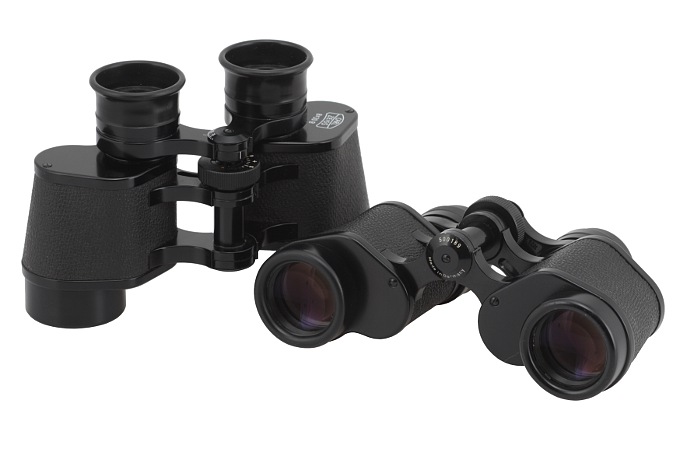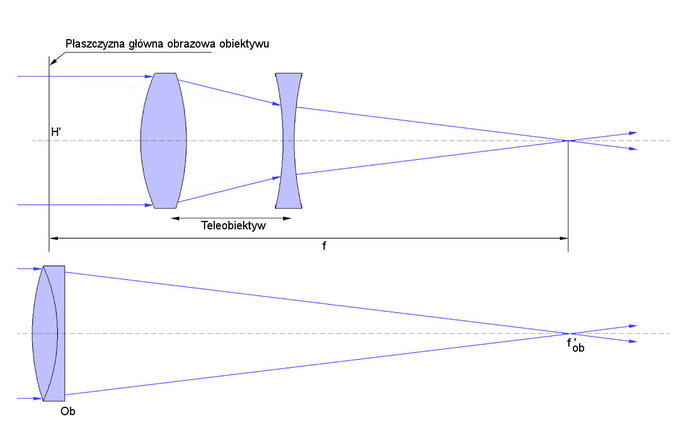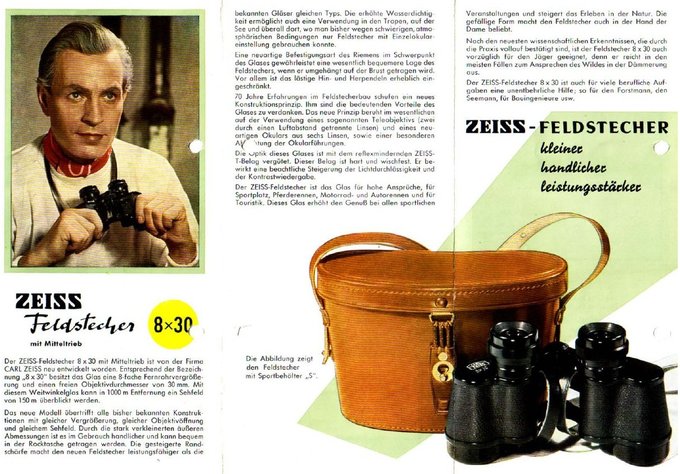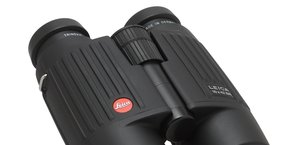Legendary binoculars - Carl Zeiss 8x30
1. Carl Zeiss 8x30 - 1954-1978
In May 1945 the American Army started to withdraw from Jena, ceding the territory to the Russians; their army entered at the end of June and the beginning of July. Like the Americans, the Russians took away what they could find – machines, documentations and staff. As a result, during just one year, about 90% of Jena equipment disappeared. Despite that fact the factory was still able to produce small amounts of 8x30, 7x50 and 10x50 pairs of binoculars with individual focusing, mainly for military use.
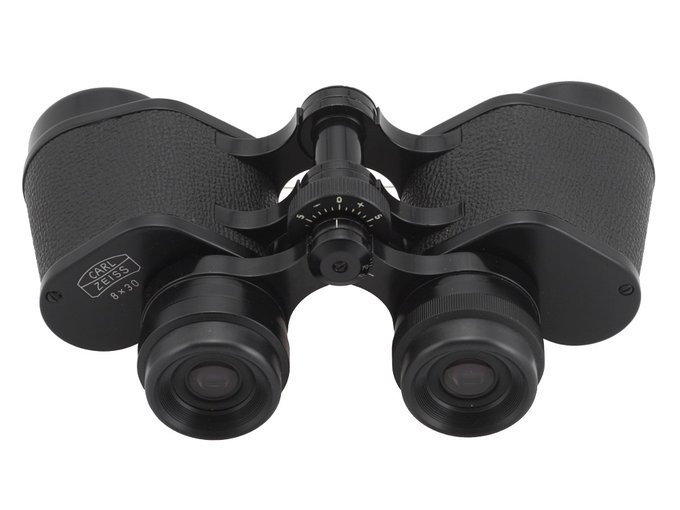 A pair of Porro Carl Zeiss 8x30 binoculars, produced around 1960. |
While the Russians were reorganizing the Jena factory a Carl Zeiss Stiftung foundation was created in the American zone and soon, in 1947, the Opton-Optische Werstatte Oberkochen GmbH factory emerged. It was situated in Oberkochen (40 km east from Stuttgart) along with the Schott Glaswerke in Mainz.
Please Support UsIf you enjoy our reviews and articles, and you want us to continue our work please, support our website by donating through PayPal. The funds are going to be used for paying our editorial team, renting servers, and equipping our testing studio; only that way we will be able to continue providing you interesting content for free. |
- - - - - - - - - - - - - - - - - - - - - - - - - - - - - - - - - - - - - - - - - - - - - - - -
At the end of the 40s and the beginning of the 50s of the twentieth century the hopes to unify Germany still seemed real enough so the Zeiss factories in Oberkochen and Jena cooperated closely with each other. For example short series of binoculars marked as Opton and officially produced in Oberkochen in reality came from the plant in Jena. What’s more, soon after the WWII the American Zeiss subsidiary resumed their business; until 60s of the twentieth century they imported devices both from Jena, Oberkochen and from Wetzlar.
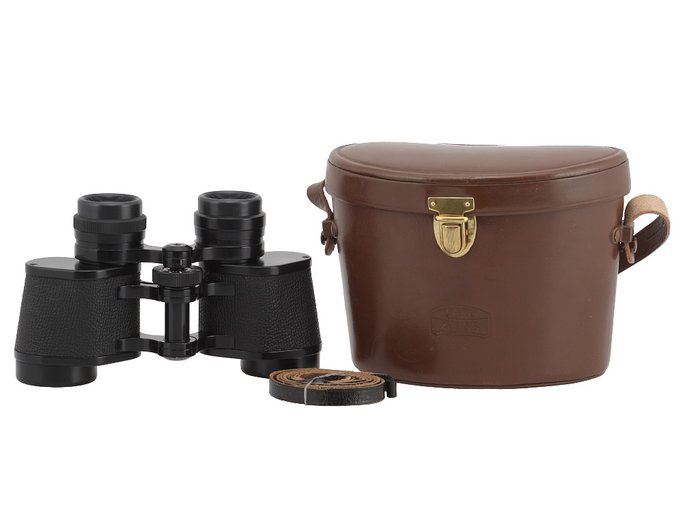 Porro Carl Zeiss 8x30 set of binoculars, produced around 1960. |
About 1952 it became clear than chances for the reunification of Germany were scant and the West-German Zeiss factory have to manage on their own. New binoculars had to be designed practically from scratch. Such a situation had also advantages. Older models, designed before the war, had to deal with reflections on air-to-glass surfaces (and losses of light on one such a surface can reach 5%). As a result the constructors tried to reduce the number of air-to-glass surfaces to the minimum. Binoculars produced after the war could use single-layer antireflection coatings which decreased losses of light on one surface to about 1.5%. It made a construction of optically more complex devices possible.
The Carl Zeiss 8x30 with accessories bought in December 1961 for 431 Marks and 20 pfennigs. Photo: M. Górko |
The opportunity was used by Horst Koehler, the Zeiss optics specialist (and a former assistant of Albert Koenig, whose eyepiece was put into the pre-war Deltrintem 8x30) who designed a completely new, compact pair of 8x30 binoculars. Its optical construction consisted of an achromatic air-spaced doublet as objective, type I divided Porro prisms and a wide-angle eyepiece with as many as six elements (2+1+1+2). Overall you got there as many as 16 air-to-glass surfaces. Taking into account the light absorption of glass, such a construction without coatings would give a transmission not higher than 40%. With good quality coatings made of magnesium fluorite the producers were able to raise the transmission to a level of 60-70%. It means it was higher than that of simpler 8x30 binoculars devoid of any coatings and produced before the war.
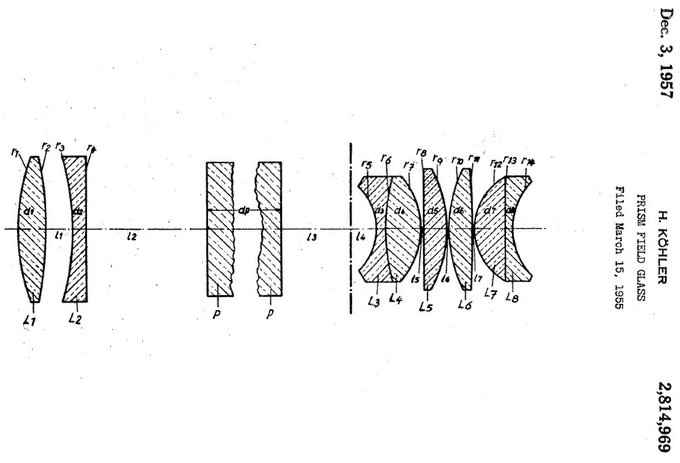 Original patent application of Horst Koehler concerning the new 8x30 pair of binoculars. |
Compact dimensions, reached by dividing the element of the objective lens and constructing a simple telephoto lens, were a huge advantage of the new binoculars. It became possible to take the main plane before the front element; the device, despite a focal length of 15 cm, was just 9 cm long.
The production of the new pair of binoculars started in 1954. The device was small, compact and physically light (from 480 to 550 grams depending on sources). It also provided a wide field for view, amounting to 8.5 degrees. Contrary to the rival Deltrintem 8x30, produced in Jena, it featured a better quality of coatings and, despite a more complex optical construction, a better transmission and colour rendering. The eyepiece, optically more complex, provided a better image quality on the edge of a quite wide field of view. The eye relief distance, amounting to just 9 mm, was the only flaw, a problem not only for people wearing glasses but also for those without any visual disorders. In winter conditions, when your eye was so close to the ocular lens it caused condensation and made observations very difficult.
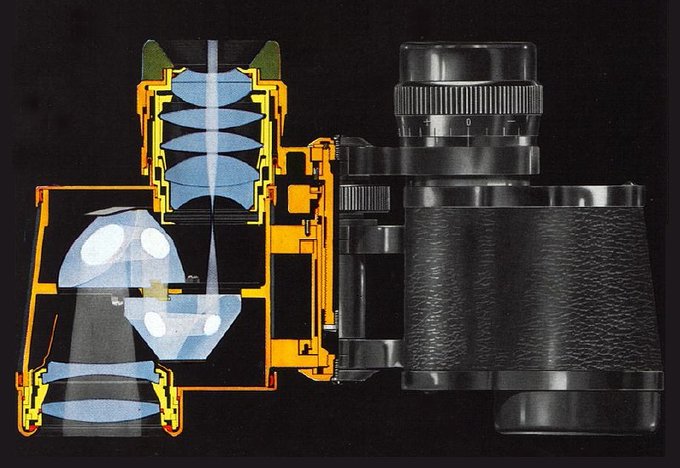 1954 Porro Carl Zeiss 8x30 binoculars. |
It’s worth adding that, from 1957, those binoculars were produced with individual focusing and aimed mainly at the army. Even earlier, in 1955 the casing of the 8x30 model (its objective lens and prisms) was used to design and launch a 6x30 model, with a field of view amounting to 8.5 degrees as well.
The new binoculars took the market by storm and small wonder –it was the most modern and the best Porro device at that time. It managed to defeat not only the Deltrintem, designed in 1920, and a whole group of its clones produced in the Eastern Bloc but also its biggest rival in the West, the Binuxit 8x30 produced by Leitz in the 1927 – 1962 period.
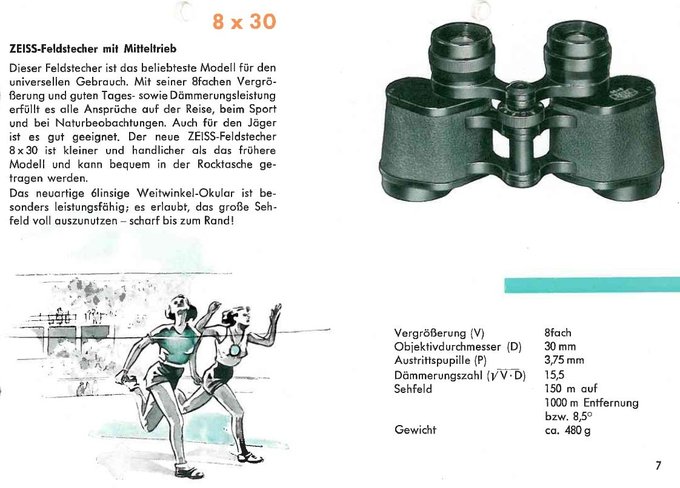 A page from the 1957 Zeiss catalogue, featuring the 8x30 binoculars |
In 1956 there was a first change in the casing of the new binoculars – elastic gaskets were added to the eyepieces to make the whole instrument more weather resistant. It was important especially during the focusing, when the ocular bridge was moved.
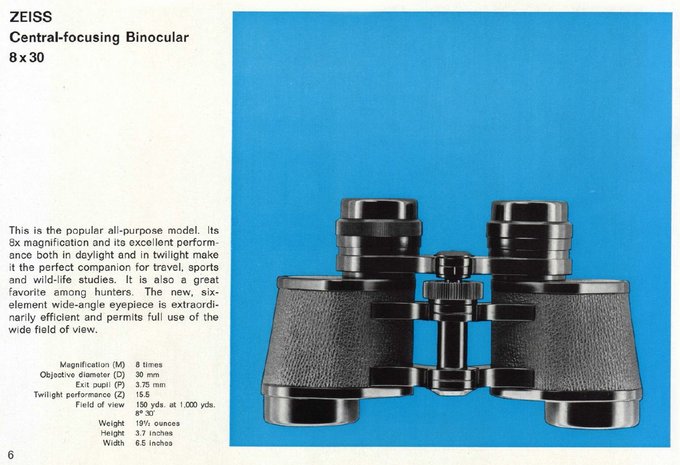 A page from the 1964 Zeiss catalogue featuring the 8x30 binoculars. |
Problems reported by the users with uncomfortable eye relief amounting to just 9 mm forced Zeiss to launch a new model on the market. Horst Koehler and Helmut Knutti undertook the task of designing of a new pair of binoculars. The construction of the objective lens and prisms was left unchanged but the eyepiece was brand new. This time, five elements were used, positioned in three groups (2+2+1).
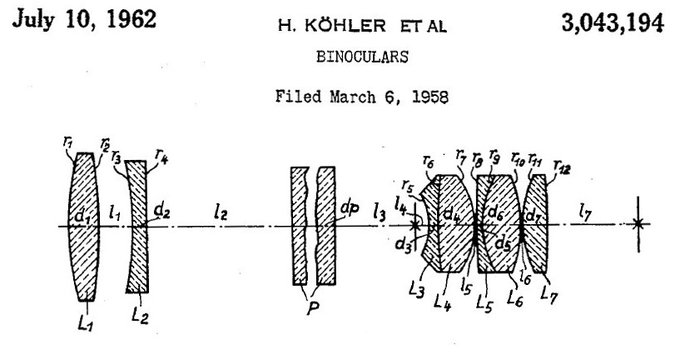 Original patent application of Horst Koehler and Helmut Knutti with a new 8x30 pair of binoculars featuring an eyepiece with an increased eye relief distance. |
The completely new eyepiece meant a new eye relief distance, amounting to as much as 19 mm. Even today it remains a very comfortable value. You can look through such a device while wearing glasses without any problems. That’s why the new model got a new marking: 8x30B (B standing for “Brillentrager” so ‘glasses wearer’) and was launched in 1958, alongside the earlier 8x30 model. In order to make the observations available for everybody, no matter whether they wear glasses or not, new folded eyecups made of rubber were added as well.
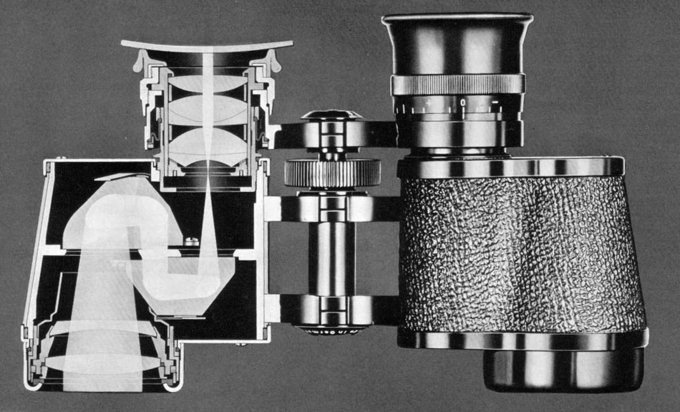 Outline of the design of the Carl Zeiss 8x30B, lanunched in 1958. |
Unfortunately there were bad news as well. The distinct increase of the eye relief affected the apparent field of view of the eyepiece which now amounted to 50 degrees. Today such a value doesn’t seem very low but in the 50s of the previous century, with the market dominated by wide angle devices with apparent fields of view of 60-80 degrees, it was really narrow. As a result the complete field of view decreased to just 6.3 degrees. As a kind of consolation you should add that the transmission of the binoculars actually improved. A lower number of elements and air-to-glass surfaces (decreasing from 16 to 14) meant better contrast, better colour rendering and good performance against bright light.
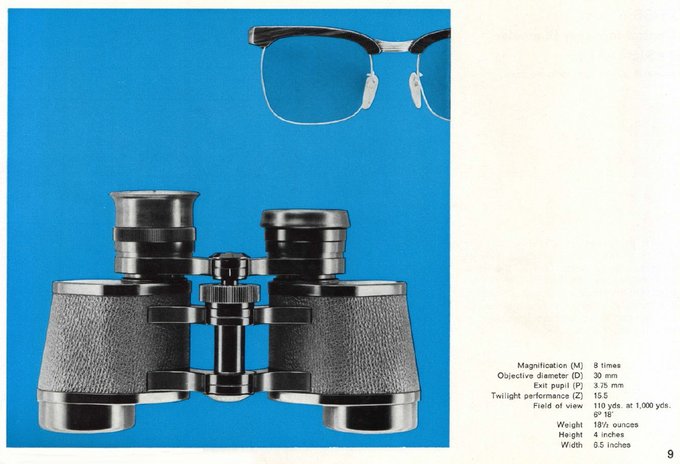 A page from the 1964 Zeiss catalogue with the description of the 8x30B binoculars. |
In 1964 the West-German Zeiss company moved their production of binoculars from Oberkochen to Hensoldt Zeiss factory in Wetzlar. Meantime the casing of both 8x30 models was modified slightly. Overall the 8x30 binoculars had six noticeable improvements during its production period (e.g. better eyepiece gaskets, new prism housing, changes near the bridge and central wheel) and the 8x30B model – only two.
After some time Zeiss noticed that they were offering two very good 8x30 devices, each of them with a serious flaw: one featured too short eye relief distance and the field of view of the second one was too narrow. Designing and launching a new model was just a matter of time.
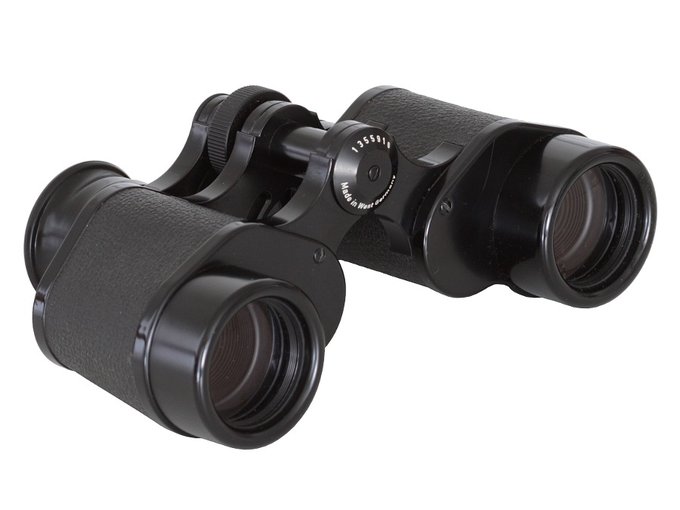 The Carl Zeiss 8x30B binoculars produced at the beginning of the 70s of the 20th century. |
In 1968 a new 8x30B pair of binoculars was launched, with a 5-element eyepiece but an apparent field of view of almost 60 degrees. The total field of the whole device was 7.4 degrees and, what’s important, the eye relief remained on the same, very comfortable level of 19 mm.
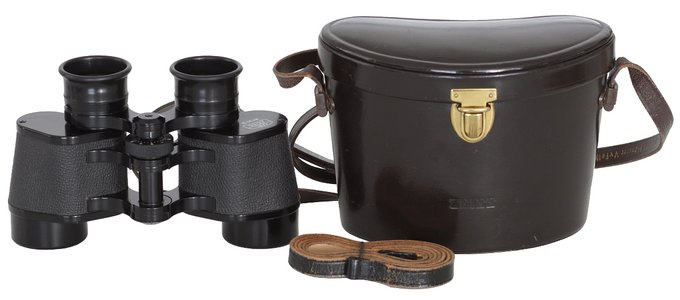 The Carl Zeiss 8x30B with accessories produced at the beginning of the 70s of the twentieth century. |
Compared to the 8x30B model with a narrower field of view the objective lens barrel of the new device was longer, sticking out more distinctly from the prism cell. It is possible the objective underwent some construction changes as well. It sounds logical, especially that a slight lengthening of its focal length, while leaving 8x magnification, increases the focal length of the eyepiece. With a bigger focal length of the eyepiece it is easier to keep a bigger eye relief while offering a wide field of view. In the 1972 catalogue from my private collection the official weight of the pair of binoculars was stated as 490 grams.
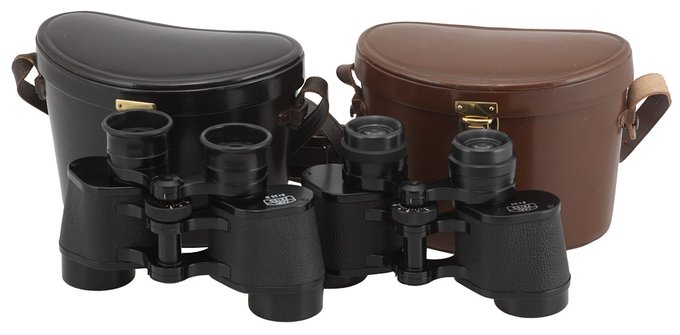 Two pairs of Carl Zeiss binoculars, the 8x30 and the 8x30B with accessories. |
To be honest, when I started writing this article I was almost sure that the last version of the 8x30B model had a telephoto objective lens practically the same as its predecessors; after all the changes were supposed to concern only the construction of the eyepiece. The photo below, showing the binoculars X-rayed, proves that the objective changed as well.
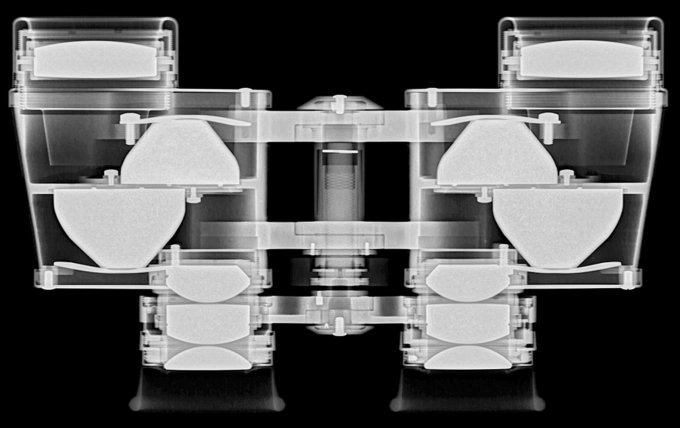 The Carl Zeiss 8x30B X-rayed. Photo: Obserwatorek. |
Contrary to the predecessors you deal here with a classic achromat. It is really interesting that the constructors abandoned the telephoto system and the length of the binoculars increased just slightly. The eyepiece, even though its field increased distinctly, has a very similar construction to the one from the previous 8x30B model - you also deal with a 2+2+1 set. The most important difference seems to concern the curvature of the element positioned the closest to the prisms.
A page from the 1972 Zeiss catalogue, describing the 8x30B binoculars. |
I didn’t manage to find more information concerning the construction of the latest version of Porro Zeiss 8x30B. Its patent motion was unavailable and I couldn’t find its optical diagram in any catalogue. Also the Zeiss employees weren’t especially helpful even though I had sent them letters with questions concerning that instrument.
The production of the Porro Carl Zeiss 8x30B binoculars ceased in 1978. It also meant a decline of such constructions in that German producer’s line-up. The era of roof prisms instruments approached fast; even at that time there were already two Schmidt-Pechan 8x30 devices in the catalogue of that company. Still, it is a material for another, equally fascinating story.




